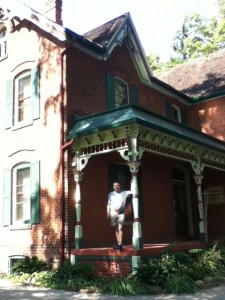
Victorian Farm House
When we learned that our $42 campground fee at Bronte Provincial Park included day use of their recreational area—a $16 dollar value—we decided to check it out. Much to our surprise we found a fully restored Victorian Farm House.
We arrived at 4:15, and immediately feared we would have to hurry up before the 4:30 closing. Well, not if Lindsey Blake had a say in the matter. Dressed in period clothing, her hair pinned back in an appropriately prim bun, Lindsey welcomed us into the year 1899, guiding us proudly through the Breckon house like a member of their family.
Although beautifully restored, the home was very dark. Lindsey explained that when Prince Albert, beloved consort of Queen Victoria, died in 1862, his bereft widow declared that the period of public mourning should be “the longest term in modern times.” The Breckon family took their Queen seriously, as their home certainly honored that sentiment.
Sharing little known facts, Lindsey made the house, the family, and the people of the Victorian era come alive. Beds were very small, leading visitors to believe that people of the Victorian era were short.
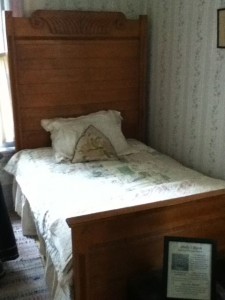
Shortened Bed
Lindsey corrected that assumption, explaining that the Victorians had many misconceptions about health. They thought that if people laid prone when they slept, the night air would make them sick. Hence, the beds were short and pillows puffed up to ensure that they would sleep in a raised position to avoid putting themselves in jeopardy.
From her recent reading, Lindsey shared the amazing fact that 16% of children died from teething. Since parents did not understand the reason for the child’s upset, they often did all the wrong things to remedy their distress. They lanced the child’s gums, they mistakenly changed the child’s food, and sometimes even withheld milk and other nutrients important to their survival.
She revealed, for example, that the front parlor and guest room were appointed with the best furniture in the house, while the doors to the other rooms were kept closed. What a great way to give visitors the impression of wealth and power!
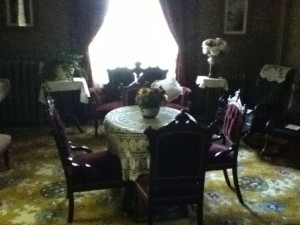
Victorian Parlor
Lindsey explained that furniture was often designed around fashion. The chairs in the parlor were armless, so the ladies could maneuver to accommodate their uncomfortable bustles out of the way. The seats also had uncommonly short legs to ensure women’s privacy, enabling them to curl their legs beneath the folds of their dresses.
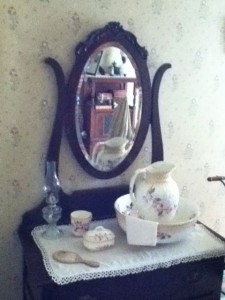
Skinny Mirror
Mirrors in the young girls’ rooms were “skinny mirrors,” made to give the illusion of a tiny waist, so growing children didn’t cinch their corsets too much and thus damage their fragile bodies.
Lindsey next ushered us into the dining room, informing us that when the carpet was rolled up the room doubled as a place where guests could dance after dinner.
“That would explain this,” she smiled as she glided over to the antique phonograph and turned it on.
Edison’s 1877 invention played rotating wax-covered metal rollers. The cylinder phonograph never achieved the popularity of its successor, which played records. The flat disc design allowed copies to be mass-produced in the manner of a printing press, whereas Edison’s cylinders had to be meticulously hand crafted.
Lindsey’s enthusiastic and well-informed tour actually made me want to head to the nearest library to learn more. When we said as much, she replied, “I’m just doing my job.” A proud member of the Natural Heritage Education program, Lindsey has set an ambitious goal: to interpret the natural and cultural features of a park, so that visitors can understand and appreciate them, and even be inspired to learn more. Thank you Lindsey, you did just that!


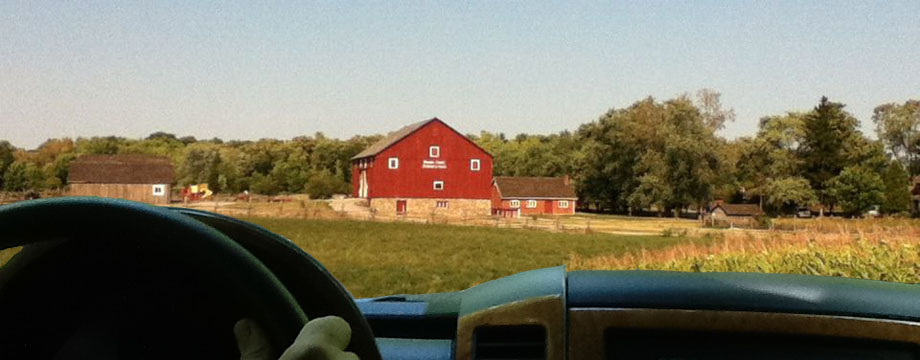
2 Responses to A Step into the Past